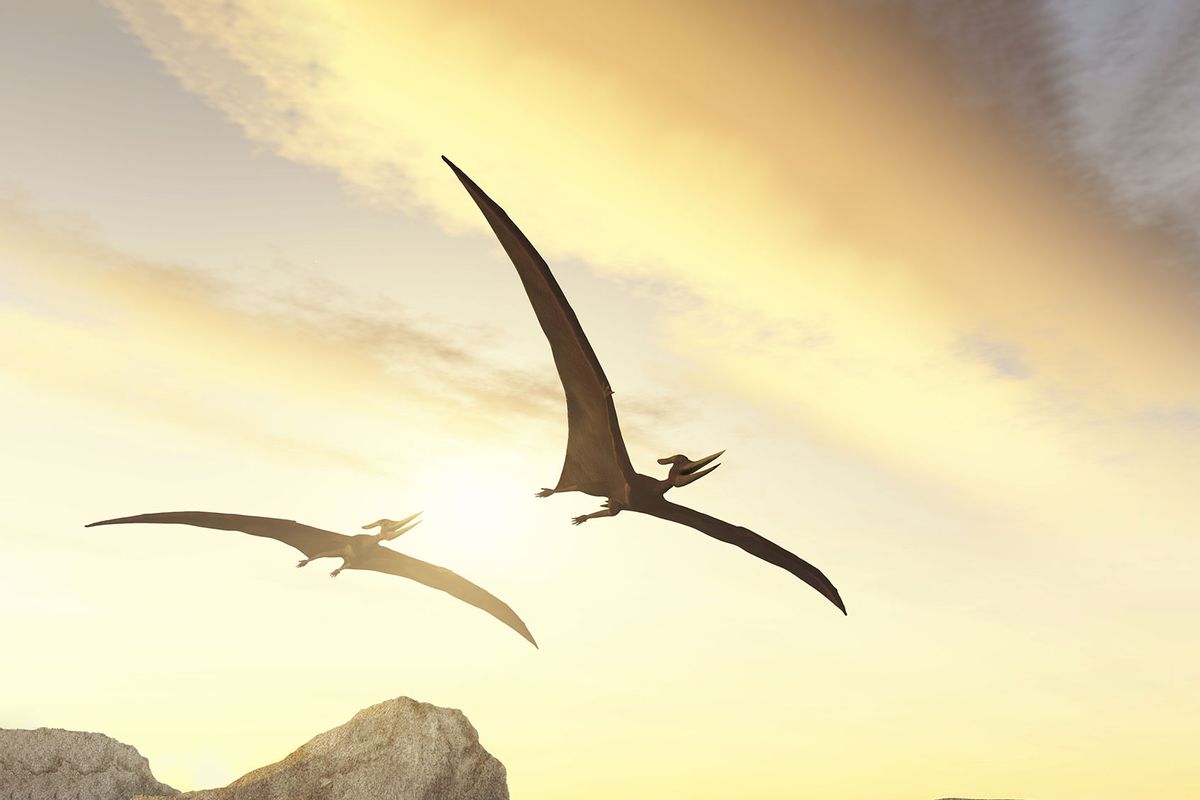Pterosaurs are perhaps the most popular dinosaur that isn't actually a dinosaur.
The massive beasts, whose name is Greek for "winged lizards," are so strongly associated with the age of dinosaurs that they memorably appear everywhere from natural history museums to movie franchises like the "Jurassic Park" series. Pterosaurs like the iconic pterodactyl are closely related to birds and other dinosaurs, and as such new discoveries about them regularly excited fans of science. That is why there has been considerable media attention around a recent study in the journal Historical Biology. Researchers from Australia have confirmed pterosaur bones that are 107 million years old, the oldest set of pterosaur bones known to the fossil record specifically on the continent.
They were able to confirm discovery of the first ever juvenile pterosaur in Australia — bones that are . . . believed to be 107 million years old.
The lead researcher, a PhD student at Curtin's School of Earth and Planetary Sciences named Adele Pentland, told SciTechDaily that Australia was much farther south during the Cretaceous Period (145-66 million years ago) than it is presently, and as a result the pterosaurs discovered in present-day Victoria would have lived within the polar circle. They would have endured "sensationally harsh conditions," surviving for weeks on end in frigid darkness.
"It is clear that pterosaurs found a way to survive and thrive," Pentland explained to SciTechDaily. "Pterosaurs are rare worldwide, and only a few remains have been discovered at what were high palaeolatitude locations, such as Victoria, so these bones give us a better idea as to where pterosaurs lived and how big they were." In addition, they were able to confirm discovery of the first ever juvenile pterosaur in Australia — bones that are, as with the other pterosaur discovered, believed to be 107 million years old.
Yet some mysteries remain. "It will only be a matter of time until we are able to determine whether pterosaurs migrated north during the harsh winters to breed, or whether they adapted to polar conditions. Finding the answer to this question will help researchers better understand these mysterious flying reptiles," Pentland added.
Want more health and science stories in your inbox? Subscribe to Salon's weekly newsletter The Vulgar Scientist.
Well-preserved pterosaur fossils are difficult to find.
These are not the only notable pterosaur discoveries in recent years. In 2022 a study in the journal Nature revealed that a pterosaur known as Tupandactylus imperator had microscopic structures in its skin known as melanosomes. Because there were different shapes of melanosomes in the pterosaur's skin as well as feathery and pillowy filament bodies within its skull, scientists concluded that pterosaur's skin was not only colored, but indeed had multiple colors. Previous pterosaur skin discoveries had only included melanosomes with the same shapes, meaning they either had the same color or were given varying hues through other chemicals in their skin. The 2022 finding was the first to confirm that pterosaurs had multiple colors in their skin.
Similarly a 2021 study in the scientific journal "Current Biology" transformed our understanding of pterosaurs by revealing the existence of a so-called "monkeydactyl" — a pterosaur with the equivalent of opposable thumbs. Officially known as Kunpengopterus antipollicatus, the small pterosaurs inhabited a "unique forest ecosystem" in Jurassic China and possessed the oldest known set of palmar (or true) opposable "thumbs." In addition to its implications for the evolution of other animals with opposable thumbs, the discovery also confirmed that pterosaurs lived in trees. "The opposed thumb is likely to have been an adaptation for that," paper co-author and paleontologist Rodrigo Pêgas of Brazil's Federal University of ABC–São Bernardo told Salon at the time. "This means that treetops were also occupied by pterosaurs during the Jurassic, along with mammals and some small dinosaurs, before birds even appeared."
Also in 2021, a study in the scientific journal iScience shed light on an enigma that had long plagued paleontologists: How could pterosaurs swoop down and scoop up large prey without breaking their necks? The study revealed that pterosaurs had spoke-like bones in their necks organized helically, like the spokes on a bicycle wheel.
"It explains that the pterosaur was able to actually carry a greater load than what we once thought, like prey items," Cariad Williams — then a Ph.D. student at the University of Illinois at Urbana-Champaign who co-authored the paper — told Salon at the time. "It was able to carry larger prey by the support of its neck . . . It actually distributed this stress along the spokes inside the vertebrae."
Not everyone agreed with the paper's finding. Dr. Alexander Kellner, a paleontologist and director of the National Museum at the Federal University of Rio de Janeiro, told the magazine Science at the time that he was "not very impressed" because "I think you should have more specimens to really make a claim." Another paper co-author, University of Portsmouth paleobiology professor Dr. David M. Martill, explained to Salon at the time that the scientists had to look specifically "at the hyper-long necked pterosaurs called azhdarchids (like Quetzalcoatlus, Hatzegopterus, Arabourgiania), not the 'ordinary pterosaurs'" because they "needed well preserved 3D material that would scan well in the CT scanner."
As it turns out, well-preserved pterosaur fossils are difficult to find. Fortunately for scientists, at least two managed to stay sufficiently intact for 107 million years.
CORRECTION: An earlier version of this story incorrectly reported that the oldest pterosaur fossil was found. It was merely the oldest in Australia. The story has been updated. We regret the error.



Shares